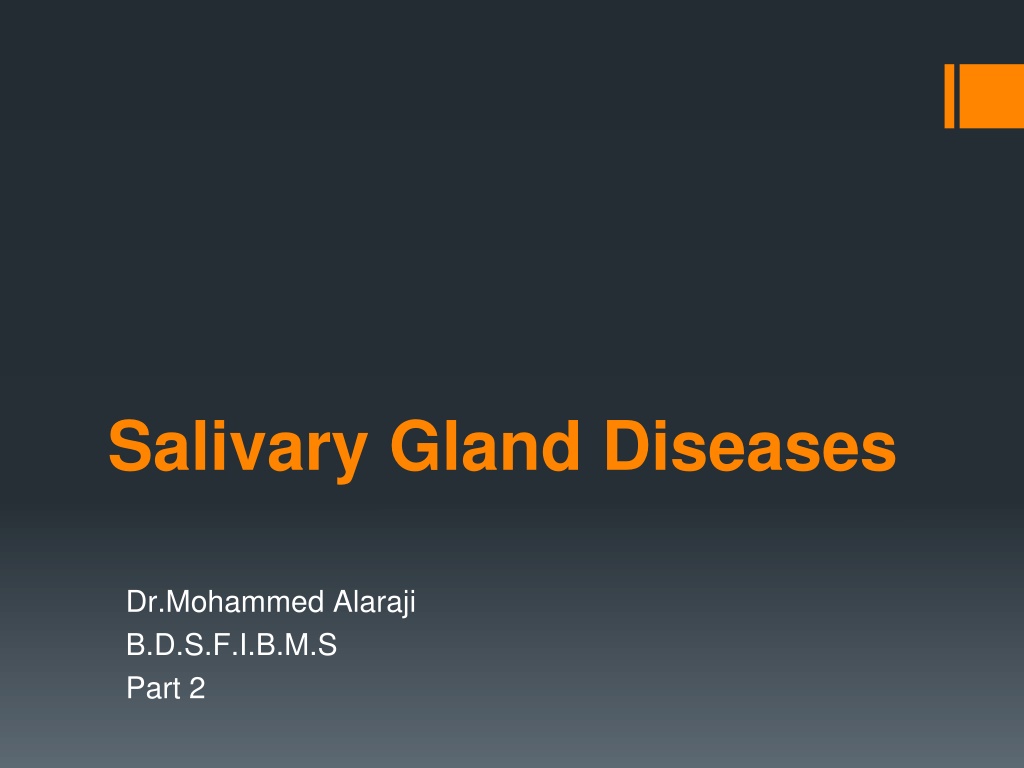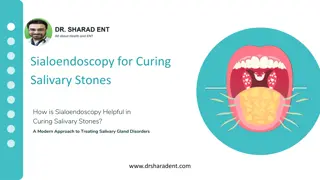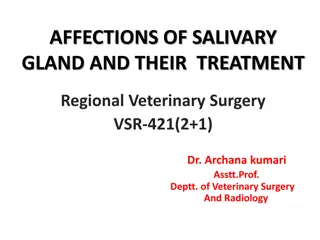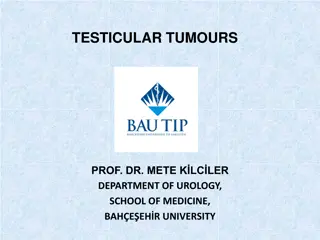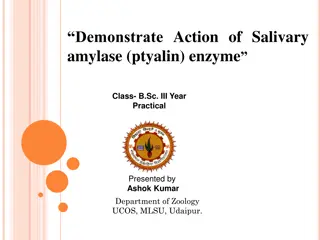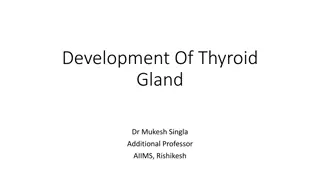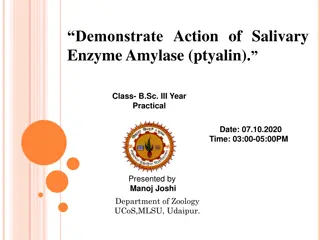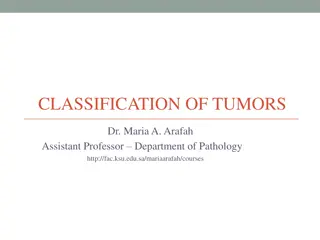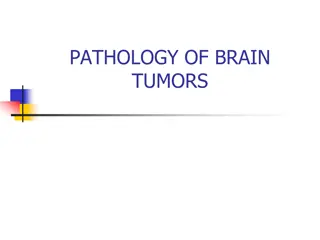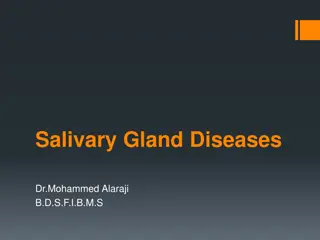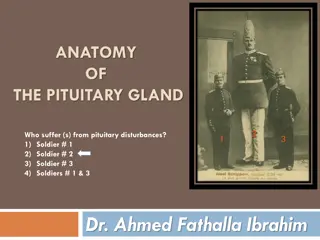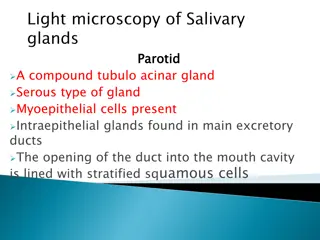Overview of Salivary Gland Tumors and Diseases
Salivary gland diseases, including tumors, can affect both major and minor glands. These tumors may be benign or malignant, with common benign tumors like pleomorphic adenoma. Clinical features of salivary gland tumors vary, with slow-growing benign tumors being more common. Pleomorphic adenoma is prevalent in the parotid gland and presents as a painless nodule without tissue destruction. Understanding these diseases is crucial for timely diagnosis and treatment.
Download Presentation

Please find below an Image/Link to download the presentation.
The content on the website is provided AS IS for your information and personal use only. It may not be sold, licensed, or shared on other websites without obtaining consent from the author.If you encounter any issues during the download, it is possible that the publisher has removed the file from their server.
You are allowed to download the files provided on this website for personal or commercial use, subject to the condition that they are used lawfully. All files are the property of their respective owners.
The content on the website is provided AS IS for your information and personal use only. It may not be sold, licensed, or shared on other websites without obtaining consent from the author.
E N D
Presentation Transcript
Salivary Gland Diseases Dr.Mohammed Alaraji B.D.S.F.I.B.M.S Part 2
TUMORS OF THE SALIVARY GLANDS The tumors of the salivary glands can affect the major and the minor glands. These tumors may be benign or malignant ones. Benign Tumors Pleomorphic adenoma, Warthin's tumor, basal cell adenoma, canalicular adenoma
Typical clinical features of salivary gland tumours Benign salivary gland tumours 1. 2. 3. Slow-growing Soft or rubbery consistency Comprise 85% of parotid tumours. Do not ulcerate. 4. 5. Malignant salivary gland tumours No associated nerve signs. 1. Some are fast-growing and painful, but many are slow growing and asymptomatic. Sometimes hard consistency. Comprise 45% of minor gland tumor. 2. 3. 4. 5. May ulcerate and invade bone. May cause cranial nerve palsies, usually lingual, facial or hypoglossal depending on the site.
Pleomorphic Adenoma Pleomorphic adenoma constitutes more than 50 percent of all tumors and 90 percent of all the benign tumors of the salivary glands. It can affect both the major and minor salivary glands; it commonly affects the parotid gland. Most of the workers believe that the tumor arises from the myoepithelial cell of the salivary gland. The different tissue types of both epithelial and connective tissue elements are seen in the tumor giving the name mixed tumor .
Clinical features Pleomorphic adenoma most commonly affects the parotid gland, followed by minor salivary glands of the palate, lip, less frequently affects the submandibular gland. The tumor starts as a small painless nodule, either at the angle of the mandible or beneath the ear lobe. Tissue destruction, pain or facial paralysis is not seen. The tumor is well circumscribed, encapsulated, firm in consistency, and may show areas of cystic degeneration. The tumor is readily movable without fixity to the deeper tissues or to the overlying skin. The intraoral pleomorphic adenomas, which affect the minor salivary glands of the palate, are noticed early, because of the difficulties in mastication, talking, etc. The palatal pleomorphic adenoma may show fixity to the underlying bone, but does not invade the bone.
Treatment surgical excision. The parotid tumors are removed with adequate margins, whereas the intraoral lesions can be treated little more conservatively.
Warthin's Tumor This benign tumor affects the parotid glands. Involvement of the submandibular or the minor salivary glands is very rare. Usually, males are affected more commonly in the 5th decade.. The diagnosis may be confirmed by biopsy. Treatment: The tumor is surgically excised
Mucoepidermoid Carcinoma The grading of mucoepidermoid carcinoma into: low-grade, intermediate grade highgrade has cleared the doubts about it's behavior. The low-grade tumor . with very good prognosis, whereas the high-grade tumor behaves very aggressive. It occurs with an equal distribution between males and females.
Clinical features depend upon the grade of the tumor. Thus, it may grow slowly or rapidly; usually as a painless swelling of the parotid or other major salivary gland, or in the minor salivary glands. Intraorally, it may affect the minor glands of the palate, buccal mucosa, tongue and retromolar areas. The high-grade tumor may produce pain, ulceration or facial paralysis, local destruction and metastasis to regional lymph nodes and distant metastasis to the lung, bone and to the brain in later stages.
Treatment The tumor should be surgically excised; the excision should be more radical than for pleomorphic adenoma
Adenoid Cystic Carcinoma It may arise as a slow growing swelling, sometimes may mimic a benign tumor clinically and histologically, but has greater potential for local destruction and invasiveness, commonly perineural invasion. Treatment: Adenoid cystic carcinoma is treated by radical excision. As the tumor is radio resistant, irradiation is not a mode of primary treatment.
NON-INFLAMMATORY AUTOIMMUNE DISEASE Sj gren's Syndrome This is a condition originally described as a triad, consisting of dry eyes, xerostomia and rheumatoid arthritis. Primary Sj gren s syndrome comprises dry mouth and dry eyes not associated with any connective tissue disease. Secondary Sj gren s syndrome comprises dry mouth and dry eyes associated with rheumatoid arthritis or other connective tissue disease. Though the etiology is unknown, various causes suggested are genetic, hormonal, infection and immuno- logic among others. Most authorities support the immunologic mechanism
Clinical Features: 1. Clinically, this disease occurs predominantly in women over 40 years of age, The female to male ratio is 10:1. 2. Typically, patients present with dry eyes and dry mouth due to hypofunction of lacrimal and salivary glands. This leads to pain, burning sensation and ulcerations on the oral/conjunctival mucosa. 3. Rheumatoid arthritis most frequently accompanies the above symptoms in secondary Sj gren's syndrome. 4. primary Sj gren's syndrome are seen to manifest parotid gland enlargement,, lymphadenopathy 5. Salivary gland function in suspected cases can be measured by using parotid flow rate, biopsy(labial biopsy) and salivary scintigraphy. Sialochemistry studies have shown elevated levels of IgA, K, Na, etc. in these patients. The sialogram shows the typical snowstorm appearance of blobs of contrast medium that have leaked from the duct system.
Management Ophthalmological review is important to exclude or treat keratoconjunctivitis sicca, which is symptomless. Dryness of the eyes is treated with artificial tears. Dryness of the mouth can be relieved to some degree by providing artificial saliva. pilocarpine, are sometimes recommended to stimulate salivary secretion. dentate patients, an aggressive preventive regime isrequired with topical fluorides and chlorhexidine mouthrinses to reduce plaque formation Soreness of the mouth due to infection by Candida albicans can be treated with fluconazole or nystatin.
Sialorrhea or Ptyalism It is excessive salivation seen in affected patients. It can be mild, intermittent or continuous profuse drooling. It can cause severe drooling and social embarrassment to the patient.
Causes of ptyalism Local reflexes Oral infections (e.g. acute necrotising ulcerative gingivitis) Oral wounds Dental procedures New dentures Systemic reflexes Nausea Oesophageal disease (reflux oesophagitis) Toxic Iodine Heavy metals: mercury, copper arsenic False ptyalism (drooling) Psychogenic Bell s palsy Parkinson s disease Stroke
The treatment is conservative. Anticholinergic medication can be tried (atropine). Behavioral modification, physical therapy has been tried. Suggested Surgical Treatment: Submandibular gland resection Transposition of parotid duct Parotid duct ligation.
Xerostomia This is a subjective sensation of a dry mouth. It affects women more than the men, and seen more commonly in older people, because of decreased glandular secretion due to aging as well as due to some medications which reduce the secretion.
Causes of xerostomia Organic causes Sj gren s syndrome Irradiation Mumps (transient) HIV infection Iron deposition (haemochromatosis, thalassaemia) Functional causes Dehydration Fluid deprivation or loss Haemorrhage Persistent diarrhoea and/or vomiting Psychogenic Anxiety states Depression Drugs Drugs Diuretic overdosage Atropine, ipratropium, hyoscine and other analogues Tricyclic and some other antidepressants Antihistamines Antiemetics (including antihistamines and phenothiazines) Decongestants Bronchodilators Appetite suppressants, particularly amphetamines
Clinical feature dry mouth with foamy, thick, ropy saliva can be noticed. The tongue may have leathery appearance and fissures with atrophy of the filiform papillae. These patients are more prone for oral candidiasis due to reduction in cleansing and antimicrobial action of saliva. Dental decay is rampant with more of cervical and root caries.
